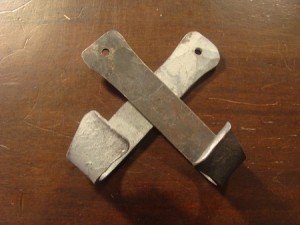Ready to dive into blacksmithing, but aren’t sure about how much blacksmith classes cost?
If you’re searching the Internet for classes near you, you might have a hard time finding class pricing.
Since Brown County Forge is in Indiana, I’ll use Indiana class offerings as the example.
Four Options for Blacksmith Classes in Indiana
There are four main options for blacksmith classes in Indiana, each with a different pricing structure and availability:
- Conner Prairie
- Indianapolis Arts Center
- Indiana Blacksmithing Association
- Brown County Forge
Conner Prairie offers a few single-day blacksmithing classes per year that last from 9 AM – 5 PM for $225-$235.
The Indianapolis Arts Center offers 8-week classes during the summer for $389 per person. Each class session is 3 hours long in the evening from 6:30 – 9:30 PM.
The Indiana Blacksmithing Association (IBA) is a not for profit organization started in 1981 “with the purposes of gathering and disseminating information about blacksmithing, exposing the public to blacksmithing, and encouraging the training of blacksmiths.”
The IBA holds meet-ups once a month at different locations around the state. During these meet-ups there will be a live demonstration and opportunities to swing hammers at no charge. Membership is $35 per year paid in June.
There are 14 IBA satellite groups around the state of Indiana.
Brown County Forge offers classes every weekend that range in price from $120 for a 3-hour Beginners Class to $220 for a 4-hour Railroad Spike Knife Making Class.
Because I focus solely on blacksmithing classes and there’s no coordination of locations, supplies, and demonstrators, I can offer classes this often.
The benefit to you is that you have the opportunity each week to learn more about blacksmithing. Even if a given weekend’s classes are full, you can always request an evening appointment.
The Price Range By the Numbers
- Conner Prairie – $235/person for 8 hour day a few times per year
- Indianapolis Arts Center – $389 over 8 weeks for 3 hours per session. A few offerings per year.
- Indiana Blacksmithing Association – $35 for annual membership. Meet-ups once a month near you with 14 groups around the state.
- Brown County Forge – $120-$220 for 3-4 hours every weekend and by appointment.
Why Does a Blacksmith Class Cost More Than $100
I can only speak from my personal experience running a business, but I would imagine that the following holds true for other organizations.
The price of a class includes these factors:
- Materials – From the steel we hammer to the fuel we use to the consumables like wire brushes and grinding belts. Everything has a cost.
- Overhead – I rent my shop space from a larger business to be able to host classes.
- Liability Insurance – In order to keep everyone safe and covered, I carry $1,000,000 in liability insurance.
- Expertise – There is value in learning from people who have extensively studied their field and put it into practice.
Here to Help!
I hope this post helps answer some questions about blacksmith class pricing. If you have other questions, please don’t hesitate to contact me:

